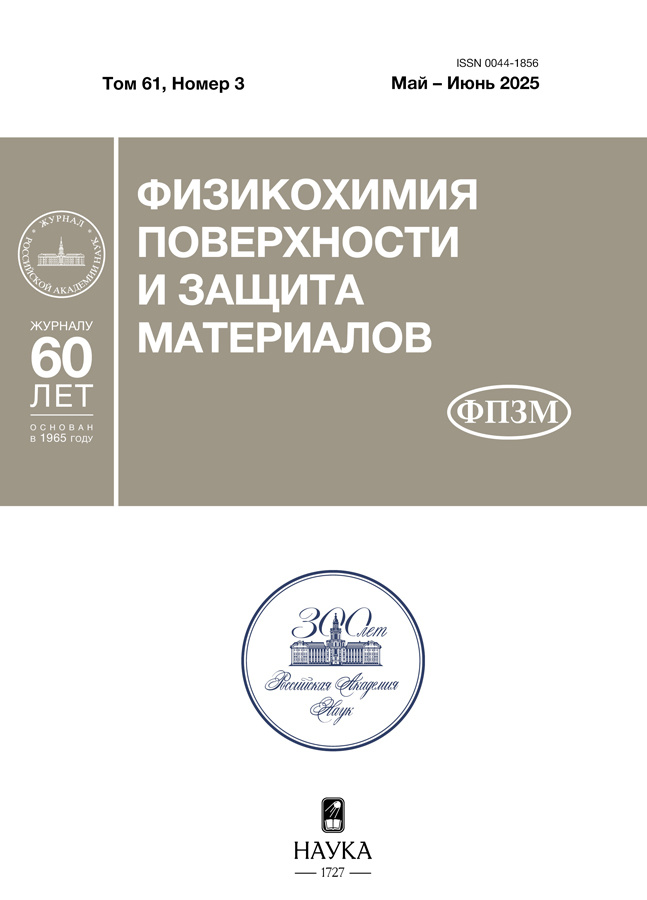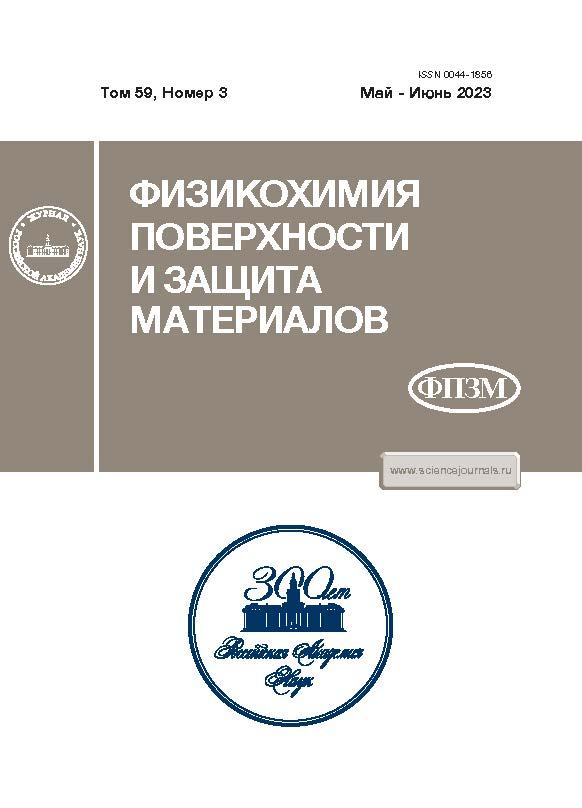Межфазное натяжение двухкомпонентных двухфазных упорядоченных твердых систем кубической формы
- Авторы: Зайцева Е.С.1, Товбин Ю.К.1
-
Учреждения:
- Институт общей и неорганической химии им. Н.С. Курнакова РАН
- Выпуск: Том 59, № 3 (2023)
- Страницы: 244-255
- Раздел: ФИЗИКО-ХИМИЧЕСКИЕ ПРОЦЕССЫ НА МЕЖФАЗНЫХ ГРАНИЦАХ
- URL: https://vestnik.nvsu.ru/0044-1856/article/view/663824
- DOI: https://doi.org/10.31857/S0044185623700304
- EDN: https://elibrary.ru/SEURGV
- ID: 663824
Цитировать
Полный текст
Аннотация
Проведен численный анализ термодинамического определения межфазного натяжения (МН) между двумя упорядоченными фазами твердого тела как избыточной величины свободной энергии ΔF двухфазной системы с учетом и без учета наличия границы раздела фаз. Граница раздела упорядоченных фаз рассмотрена в рамках данной геометрии домена как совокупность кубических монослоев с переменной плотностью компонентов, включая кубическую форму разделяющей поверхности. Дан микроскопический анализ обобщения термодинамического подхода Гиббса, вводящего межфазное натяжение на математической поверхности раздела фаз, на случай сложной кубической формы границы, содержащей угловые области куба с локальными межфазными натяжениями для граней, ребер и вершин граней. Расчет проведен в простейшем варианте модели решеточного газа при учете взаимодействия ближайших соседей в квазихимическом приближении. Каждый узел двухкомпонентной смеси на жесткой решетке может быть занят компонентами смеси А + В и вакансиями V. Сопоставлены два основных способа расчета МН, которые выражаются через разные парциальные вклады \(M_{f}^{i}\) в избыточную свободную энергию ΔF (здесь i = A, В, V – вакансии, 1 ≤ f ≤ t, t – число типов узлов разного типа, зависящее от положения узла внутри угловых областей куба). Получена неоднозначность значений МН в зависимости от вида функций \(M_{f}^{i}\) для зависимости МН от размера домена при фиксированной температуре. Обсуждается роль вакансий как основной механической характеристики двухкомпонентной смеси в МРГ при условии строгого фазового равновесия по трем частным равновесиям (механического, теплового и химического). Показано, что если проводить расчеты МН для двух плотных расслаивающихся фаз в пренебрежении учета вакансий, то это искажает реальную величину МН.
Об авторах
Е. С. Зайцева
Институт общей и неорганической химии им. Н.С. Курнакова РАН
Email: tovbinyk@mail.ru
Россия, 119991, Москва, Ленинский пр-т, 31
Ю. К. Товбин
Институт общей и неорганической химии им. Н.С. Курнакова РАН
Автор, ответственный за переписку.
Email: tovbinyk@mail.ru
Россия, 119991, Москва, Ленинский пр-т, 31
Список литературы
- Хачатурян А.Г. Теория фазовых переходов и структура твердых тел. М.: Наука, 1974. 384 с.
- Штремель М.А. Прочность сплавов. Часть 1. Дефекты решетки. М.: МИСИС, 1999. 384 с.
- Иона Ф., Ширане Д. Сегнетоэлектрические кристаллы. М.: Мир, 1965. 556 с.
- Кацнельсон А.А., Олемской А.И. Микроскопическая теория неоднородных структур. М.: Изд-во МГУ, 1987. 333 с.
- Иона Ф., Ширане Д. Сегнетоэлектрические кристаллы. М.: Мир, 1965. 556 с.
- Вакс В.Г. Введение в микроскопическую теорию сегнетоэлектриков. М.: Наука. 1973. 327 с.
- Лайнс М., Гласс А. Сегнетоэлектрики и родственные им материалы. М.: Мир, 1981.
- Струков Б.А., Леванюк А.П. Физические основы сегнетоэлектрических явлений в кристаллах. М.: Наука, 1983. 240 с.
- Хуберт А. Теория доменных стенок в упорядоченных средах. М.: Мир, 1977. 308 с.
- Киттель Ч. Введение в физику твердого тела. М.: Книга по Требованию, 2012. 789 с.
- Чернов Ф.Ф., Гиваргизов E.И., Багдасаров Х.С., Демьянец Л.Н., Кузнецов В.А., Лобачев А.Н. Современная кристаллография. Т. 3. 1980. 408 с.
- Сиротин Ю.И., Шаскольская М.П. Основы кристаллофизики. М.: Наука, 1979. 640 с.
- Займан Дж. Модели беспорядка. М.: Мир, 1972. 592 с.
- Ландау Л.Д. // Сбор. научн. тр. М.: Наука, 1969. Т. 1. С. 97.
- Ландау Л.Д. // Сбор. научн. тр. М.: Наука, 1969. Т. 1. С. 123.
- Ландау Л.Д. // Сбор. научн. тр. М.: Наука, 1969. Т. 1. С. 234.
- Ландау Л.Д., Лифшиц Е.М. // Сбор. научн. тр. М.: Наука, 1969. Т. 1. С. 128.
- Физика сегнетоэлектриков. Современный взгляд. Под редакцией К.М. Рабе, Ч.Г. Ана, Ж.-М. Трискона. Москва БИНОМ. Лаборатория знаний 2015. 442 с.
- Кочервинский B.В. // Высокомолекулярные соединения. Серия Б. 2005. Т. 47. № 3. С. 542.
- Фридкин В.М. // УФН. 2006. Т. 176. № 2. С. 203–212.
- Фридкин В.М., Дюшарм С. // УФН. 2014. Т. 184. № 6. С. 646.
- Гиббс Дж. В. Термодинамика. Статистическая механика. М.: Наука. 1982. 584 с.
- Ландау Л.Д., Лифшиц Е.М., Теоретическая физика. Т. 8. Электродинамика сплошных сред. 1982. С. 212, 216.
- Товбин Ю.К. Малые системы и основы термодинамики. М.: Физматлит, 2018. 408 с. (Tovbin Yu.K., Small systems and fundamentals of thermodynamics, CRC Press, Boca Raton, Fl, 2019).
- Товбин Ю.К., Зайцева Е.С., Рабинович А.Б. // Журн. физ. химии. 2017. Т. 91. № 10. С. 1730.
- Товбин Ю.К., Зайцева Е.С. // Теплофизика высоких температур. 2018. Т. 56. № 3. С. 381.
- Зайцева Е.С., Товбин Ю.К. // Журн. физ. химии. 2020. Т. 94. № 6. С. 951.
- Зайцева Е.С., Товбин Ю.К. // Журн. физ. химии. 2021. Т. 95. № 10. С. 1481.
- Зайцева Е.С., Михайлова Т.Ю., Долин С.П., Товбин Ю.К. // Неорганические материалы. 2022. Т. 58. № 6. С. 484.
- Зайцева Е.С., Товбин Ю.К. // Журн. физ. химии. 2022. Т. 96. № 10. С. 1411.
- Товбин Ю.К. // Журн. физ. химии. 2022. Т. 96. № 11. С. 1547.
- Товбин Ю.К. // Журн. физ. химии. 1992. Т. 66. № 5. С. 1395.
- Товбин Ю.К. // Журн. физ. химии. 2016. Т. 90. № 7. С. 1059.
- Товбин Ю.К. Теория физико–химических процессов на границе газ–твердое тело. М.: Наука, 1990. (Tovbin Yu.K. Theory of physical chemistry processes at a gas–solid surface processes. Boca Raton, Fl.: CRC Press, 1991.)
- Товбин Ю.К. // Физикохимия поверхности и защита материалов. 2020. Т. 56. № 4. С. 339.
- Зайцева Е.С., Товбин Ю.К. // Физикохимия поверхности и защита материалов. 2020. Т. 56. № 5. С. 451.
- Гиршфельдер Дж., Кертис Ч., Берд Р., Молекулярная теория газов и жидкостей. М.: изд-во иностр. лит., 1961. 929 с. (Hirschfelder J.O., Curtiss C.F., Bird R.B. Molecular Theory of Gases and Liquids. N.Y.: Wiley. 1954.)
- Зайцева Е.С., Товбин Ю.К. // Химическая физика. 2023. Т. 42. № 8. В печати.
Дополнительные файлы


















